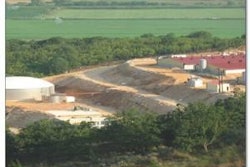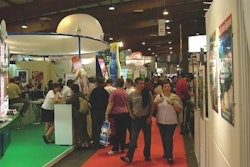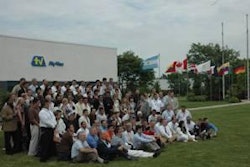There is no magic, undiscovered feed ingredient that cuts feed costs dramatically during times when maize and soybean prices increase dramatically. But there are alternative feeds and additives that can save the industry significant amounts of money, speakers said at the WATT Online Animal Nutrition and Heath Forum session on alternative feed ingredients.
Maize and corn are very efficient to produce, with maize a “spectacularly good” energy feed, with soybean meal a “very good” protein source, “and that puts us in a bit of a problem with alternative ingredients because any alternative ingredient will be swimming uphill,” said Dr Nick Dale, University of Georgia, USA, poultry scientist.
Dale defines alternative feeds as those that have not been used on a regular basis, such as sorghum, canola, and sunflower meal in the Southeast U.S., their nutritional levels have yet to be defined— biofuel by-products falls into this category—and the maximum inclusion level is unclear.
Some suggest that bakery byproducts are alternative ingredients, “but there is nothing alternative about bakery meal,” it, along with animal proteins, are very well accepted ingredients.
Dale said that some alternative feeds include peanut meal, cottonseed meal, pearl millet, catfish meal, and for producers in countries where it’s produced, tilapia meal. The challenge in using some alternative ingredients, however, is their variability. Distillers dried grains with solubles, for example, has protein of 26% to 29%, and tilapia meal has a lysine content of 3.01% to 3.59%.
Dale said that altnernative feeds may serve niche needs for poultry producers. For example, cottonseed meal may have a place in feeding heavy breeder pullets.
“It has interesting characteristics that we wouldn’t normally think of as a positive. We want heavy breeder pullets to grow, but not too much, and uniformly.”
This is normally done by restricting energy, but it could also be done by feeding cottonseed meal, which is a very good feed, has only half the lysine content of soybean meal. In a study Dale conducted, birds did very well on cottonseed meal. They were pulled off the diet at 16 weeks, which gave plenty of time for gossypol to be eliminated prior to the onset of production, Dale said.
There are opportunities with alternative ingredients, but it’s important to get used to them prior to a crisis.
Distillers grains
One of the issues in using alternative grains such as distillers dried grains with solubles (DDGS) is that most of the starch has already been removed and that creates challenges for pellet binding, said Dr Dan Rollins, director of feed production and feed quality management for Aviagen. That said, if they’re dried correctly, DDGS products are not any more difficult to handle than products the industry has been using for years, such as wheat midds.
Rollins said that one of the major challenges is the variability of DDGS products. For example, a 32-plant study contained in a DDGS handbook, showed the following variability: dry matter, 89.3% to 90%; crude protein protein, 30.9% to 32.9%; crude fat, 10.7% to 12.4%; crude fiber, 7.2% to 10.4%; and ash, 6% to 9.8%. “The crude fat variability is important from a pelleting viewpoint,” Rollins said. He added that DDGS is a high fat product.”
Rollins continued that another challenge is penetrating the DDGS particles given the variation in particle size, but operators are finding ways to do this. Methods include using a double conditioning, extruders, and retention vessels that have been developed but are not commercially available just yet.
“People are doing a better job with conditioning,” he said.
Rollins also said that dyes are being developed that do a better job of conditioning DDGS. Products also have been developed that improve flow through the dye, such as flow agents and binders combined with flow agents.
Byproducts
According to a study done in November, the average by-product meal usage was 4% in 140 U.S. poultry complexes surveyed by Agri-Stats, and increasing that by just 3% alone would cut feed costs by $3 to $5 per ton. Increasing by-product meals can result in “a significant savings in feed costs, but it does come at some risk,” said Dr Tom Frost, director of nutrition and research for Wayne Farms LLC. For example, he said, companies thinking of increasing by-product feeds need to ask themselves how—if at all—pellet quality will be hurt. He added that feed yields should not be affected with by-product feeds.
Enzymes also can cut feed costs, he said. Phytase enzymes, which have been available to the industry for 10 to 15 years, “has been a significant savings to the industry. Frost said that defluorinated phosphate is very abrasive and polish the stainless steel dye, while other phosphate sources do not. The minimum advantage of using phosphate enzymes, he said, is the removal of 12 lbs. (5.5 kg) of phosphate for a cost savings of $1-2/ton.
In addition, Frost said, there are several new maize-soy enzymes now available on the market. “With the cost of fat, NSP enzymes have been a considerable savings,” he said. NSP enzymes focus primarily on the non-starch polysaccharide fractions in soybean meal. Most companies claim about 40 kcal/lb (88kcal/kg) of metabolizable energy release, he said. Energy release is the NSP enzyme’s primary role. Frost said individual companies will have to do their own research and decide what they’re comfortable with, but the benefit “is in the range of 40 to 50 kcal/lb.
NSP enzymes include Xylanase, amalase, mannanese, glucanase, and protease. Frost added, however, that heat stability with these enzymes “is a potential issue in older feed mills.” One advantage to using NSP enzymes, he said, “is just getting fat (16-24 lbs., 7-11 kg), with a cost savings of 50 cent to $2/ton. Another advantage is to reduce the risk of poor quality fat. He said that using NSP enzymes reduce 3% of fat used and in 5,000 tons/week will reduce two trucks/week. “I see that as a strong advantage,” he said.
Frost continued that the typical usage of DDGS in broiler feeds is 2% to 6%, and that can save $1.50 to $3/ton, although the challenge is variability.
“A lot of the alternate feed discussion gets down to your feedmill. Do you have the space to handle ingredients? Can you handle multiple grain and protein sources? Many of our feed mills can’t, but some can.” Another alternate feed for the U.S., although widely used in Europe, is wheat.
“Wheat requires the use of a xylanase enzyme," he said, and litter moisture is a concern, as is intestinal viscosity.
Adding all these things at the same time, Frost said, totals $11/ton, “but in reality, let’s say $5/ton. Five dollars is a pretty small number compared to the $150/ton increase in feed costs that occurred in 2008.
“We have to keep things in perspective. We’re going to take some risk in using alternate ingredients to save on feed costs. We have to be careful what to do, what risks to take in changing the diet around.”
As important as cost cutting is, Frost advised not to overlook the importance of pellet quality. “Birds improve with improved pellet quality,” he said. Improved pellet quality equals improved performance, Frost added. A 2008 study shows that a 10% improvement in the percentage equals a 2.0 point improvement in feed conversion. A 5% increase in pellets in the pan equals 1.0 points in feed conversion, he said. Pellet quality is much more important in a low-density feed, Frost stated.
“There’s money to be had if we can get improved pellet quality.”
He said in response on whether it’s cost effective to stop pelleting that 35% to 45% pellets is worth about 8 points feed conversion compared to mash feed.
“If you can slow down and capture pellet quality it easily pays for itself,” he stated.


















